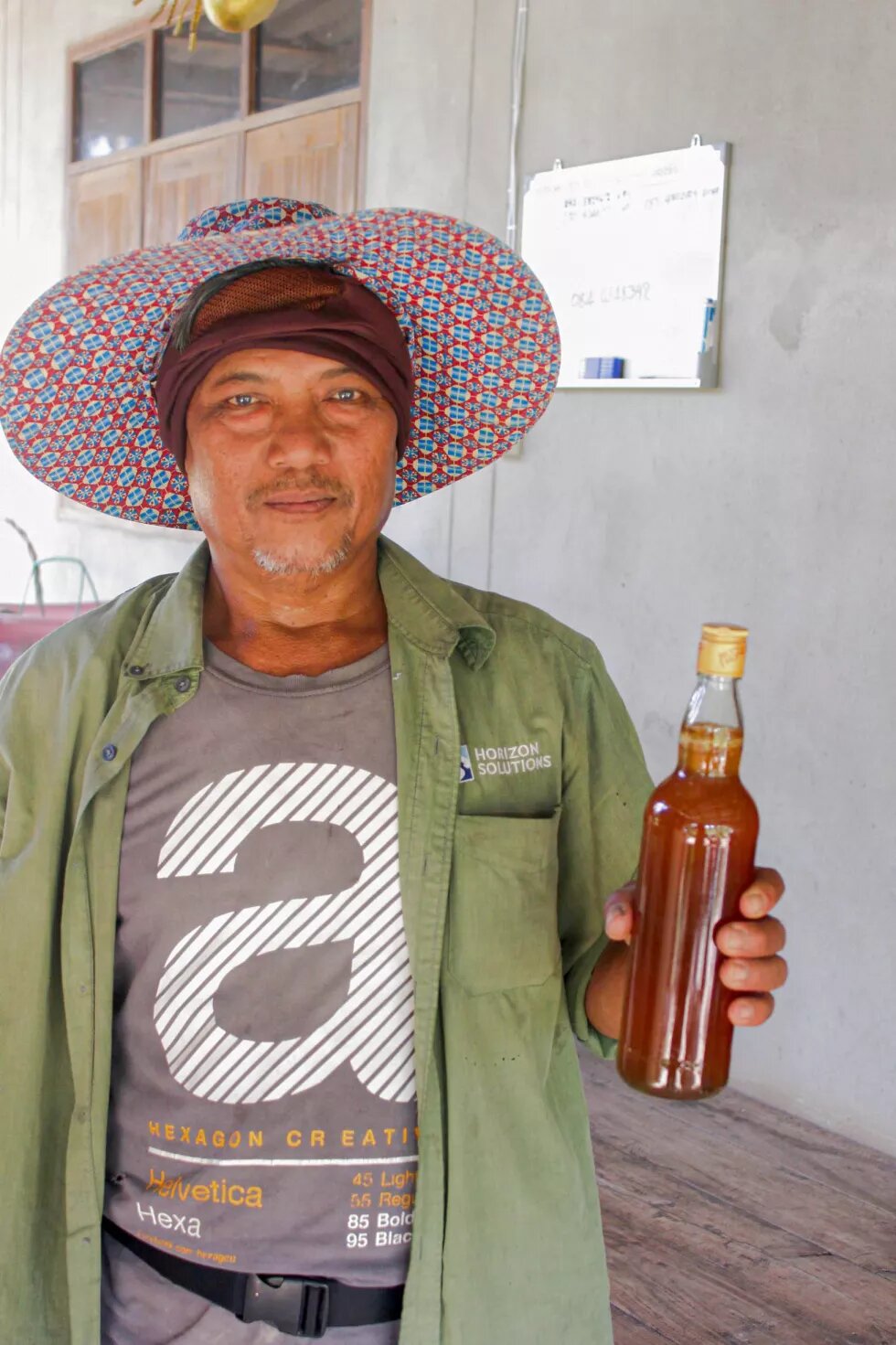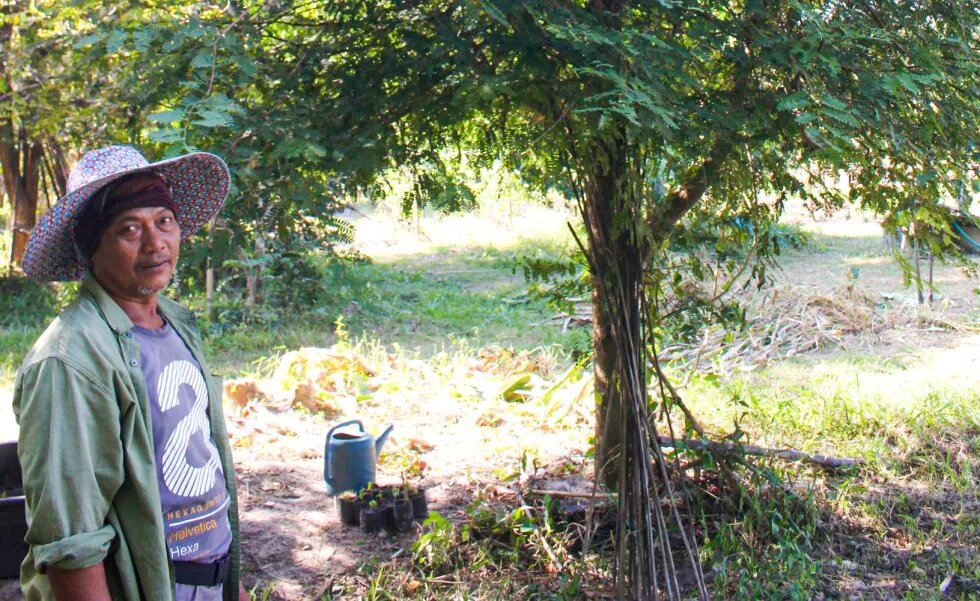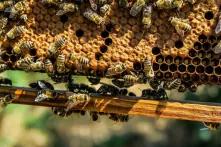
Mr. Sin Hengsamai and his wife. Mrs. Kuchanat Khemlai are organic farmers, members of the Sanam Chaikhet Organic Farming Group. However Sin prefers to work on the farm and stay at home, so Mrs. Kuchanat is the visible member of the group, whether at the weekly organic farmers market in the Sanam Chaikhet Hospital or at group meetings and events.

During the past Thai summer in March, I found one of our favorite organic farmers, Mrs. Kuchanat Khemlai, was selling some bottles of honey. She told me this was Apis florea honey. I bought a bottle to take home and found the flavor and quality are majestic. For a number of weeks during the summer period she would bring a bottle or two to sell at the market. Having tasted the wonderful quality of this honey and knowing of the health value of native and florea honeys from presentations by Dr. Orawan Duangphakdee, I would buy a bottle each week if there was one left.
While I had some access to cerana and dorsata honey, I had rarely come across Apis florea honey and here Mrs. Kuchanat was able to bring a couple bottles each week. I wanted to learn more about how these bees were managed. While I knew the honey harvester was someone close to her, only when I asked if I could visit and learn more did she tell me this was no other than her husband Mr. Sin Hengsamai. Receiving his mobile number, I asked him if I might visit to learn a bit more and interview him about his knowledge and experience with these native bees.
Mr. Sin Hengsamai and his wife. Mrs. Kuchanat Khemlai are organic farmers, members of the Sanam Chaikhet Organic Farming Group. However Sin prefers to work on the farm and stay at home, so Mrs. Kuchanat is the visible member of the group, whether at the weekly organic farmers market in the Sanam Chaikhet Hospital or at group meetings and events.
We sat down for a chat outside his home in Ban Yang Daeng village, in Khuyai Mee subdistrict, Sanam Chaikhet district, Chachoengsao province on a nice breezy December day.
Michael Commons: "Regarding native bees, how many years have you been collecting wild honey?”
Sin Hengsamai, “I started to collect wild honey when was about 20 years old. Now I am 53. So about 30 years.”
MC: “What was it was like then?”
SH: “There was not much work to at that time and this was hobby. I collected honey to use for my own use as an herb and medicine.”
“Back then, it was easier to find wild bee hives. I found many florea hives as well as some cerana and dorsata, but I don't have expertise to collect dorsata honey. In this area florea hives are most abundant.”
MC: “Did you mix the honey with herbs for use as medicine?”
SH: “No, I didn't mix with other herbs, but I believe that florea honey is medicine in itself as the bees collect pollen and nectar from many different herbs. So I just mix with warm water and drink and this is good medicine.”
MC: "Now do you find fewer bees?”
SH: “Yes they have decreased because the environment is not healthy."
MC: “Is there a way we can help bring back the bee population?
SH: “We stopped using chemicals and this can help but unfortunately this has not widely adopted and we are a small group.” (the Sanam Chaikhet Organic Farmer Group)
MC: “Is there a way to collect the honey to minimize the disturbance to the bees?”
SH: “If we collect honey in the correct many it will not greatly disturb the bees.”
MC: “How do we do this?”
SH: “We don't kill the bees, we just use some smoke to disperse them. Then we also can observe the nest to see that most of the brood have matured and left the nest and the nest is old already. In such case, the population will be strong and they can rebound quickly, then we can take the honeycomb.”
“We try to only take the honeycomb from above and leave the brood comb attached to the branch. In this way they can rebuild quickly. However it is not always easy with florea as the branch is small and the honeycomb is on the top.”
“If the brood comb is not damaged and no one else is collecting honey from the same hive, we can collect honey 2 or 3 times during the peak honey period of March and April.”
MC: “When is the honey production period here?”
SH: “We can start to collect in February from florea and go until April or early May.”
MC: “Do the bees stay in the same area?” (in the rainy season)
SH: “Yes they stay in the same area but their populations are smaller and they produce little honey.
Their populations will start to increase in January and February but the most honey is produced in the Thai 5th lunar month of April, but now this is the last month of honey.
There should be some honey throughout the whole year, but there is the issues of over-harvesting and those who remove the whole nests thus depleting the population.”
MC: “Do you plant some crops for the bees in particular?”
SH: “We plant diverse vegetables and leave the wild flowers and this attracts the bees. All types of flowers help provide for the bees. They also need a source of clean water. If there is a creek or river this will provide for them. It can be a pond as well but needs to be clean water (not putrid water).
In the morning they collect the dew from the leaves and this may be enough with nectar. Natural waterways also provide a diversity of plants and flowers.”
MC: “What would you say to consumers who think that wild native florea honey is expensive?”
SH: “I don't think it is expensive at all, it is very difficult to find and collect.”
MC: “Do you think the quality is different from market honey?”
SH:”Market honey which is farmed honey is different. The nectar and pollen which is most medicinal comes from natural and wild areas, which is collected by native bees. So it is more medicinal than market honey.”
MC: “If people want to support restoration of native bees, what advice can you offer?”
SH:”I can only say that we should stop using pesticides and chemicals and help prevent forest fires.”
During our walk around his farm he also shared that “Florea are very hardworking and help to pollinate and increase fruit set. They will collect nectar from many different small flowers and are most active in the morning from sunrise to about 8 am.”
He showed me two Apis florea hives on his farm at present, one in an orange jasmine bush and another in a tamarind tree. He said there was another one high up in at thicket of bamboo. His land clearly had quite a diversity of crops and trees. He said that tamarind and starfruit were both particularly interesting as they flower throughout the year. Orange jasmine also flower prolifically a number of times in a year.
He said the from one florea hive he can normally only collect about 500 gms of honey. With a rare large and healthy hive he may be able to collect enough to fill one 750 ml bottle.



